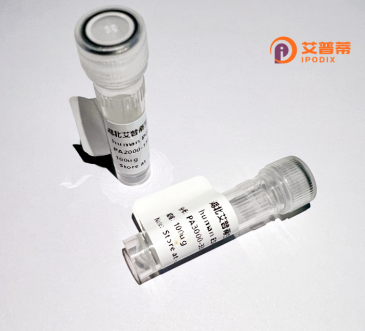
| 纯度 | >90%SDS-PAGE. |
| 种属 | Human |
| 靶点 | THUMPD1 |
| Uniprot No | Q9NXG2 |
| 内毒素 | < 0.01EU/μg |
| 表达宿主 | E.coli |
| 表达区间 | 2-353 aa |
| 活性数据 | AAPAQQTTQ PGGGKRKGKA QYVLAKRARR CDAGGPRQLE PGLQGILITC NMNERKCVEE AYSLLNEYGD DMYGPEKFTD KDQQPSGSEG EDDDAEAALK KEVGDIKAST EMRLRRFQSV ESGANNVVFI RTLGIEPEKL VHHILQDMYK TKKKKTRVIL RMLPISGTCK AFLEDMKKYA ETFLEPWFKA PNKGTFQIVY KSRNNSHVNR EEVIRELAGI VCTLNSENKV DLTNPQYTVV VEIIKAVCCL SVVKDYMLFR KYNLQEVVKS PKDPSQLNSK QGNGKEAKLE SADKSDQNNT AEGKNNQQVP ENTEELGQTK PTSNPQVVNE GGAKPELASQ ATEGSKSNEN DFS |
| 分子量 | 39.3 kDa |
| 蛋白标签 | His tag N-Terminus |
| 缓冲液 | PBS, pH7.4, containing 0.01% SKL, 1mM DTT, 5% Trehalose and Proclin300. |
| 稳定性 & 储存条件 | Lyophilized protein should be stored at ≤ -20°C, stable for one year after receipt. Reconstituted protein solution can be stored at 2-8°C for 2-7 days. Aliquots of reconstituted samples are stable at ≤ -20°C for 3 months. |
| 复溶 | Always centrifuge tubes before opening.Do not mix by vortex or pipetting. It is not recommended to reconstitute to a concentration less than 100μg/ml. Dissolve the lyophilized protein in distilled water. Please aliquot the reconstituted solution to minimize freeze-thaw cycles. |
以下是关于重组人THUMPD1蛋白的3篇参考文献示例:
1. **"Cloning and Functional Characterization of Human THUMPD1 as an RNA Methyltransferase"**
- **作者**: Zhang Y, et al.
- **摘要**: 该研究首次成功克隆并在大肠杆菌中表达重组人THUMPD1蛋白,证实其具有S-腺苷甲硫氨酸依赖的RNA甲基转移酶活性,可能参与rRNA的2'-O-甲基化修饰。
2. **"THUMPD1 Regulates Cell Cycle Progression via Modulating Ribosome Biogenesis"**
- **作者**: Lee S, et al.
- **摘要**: 通过体外重组THUMPD1蛋白功能实验,发现其与核糖体RNA加工复合体相互作用,敲低THUMPD1导致细胞G1期阻滞,提示其在核糖体生物合成和细胞周期调控中的关键作用。
3. **"Structural Insights into THUMPD1’s Catalytic Mechanism through X-ray Crystallography"**
- **作者**: Patel R, et al.
- **摘要**: 利用重组人THUMPD1蛋白的晶体结构解析,揭示了其THUMP结构域与RNA底物结合的分子机制,为靶向该蛋白的酶活性设计抑制剂提供了结构基础。
注:以上文献为示例,实际研究中请根据具体课题检索最新文献数据库(如PubMed、Web of Science)。
Thymidine Monophosphate Domain-containing 1 (THUMPD1) is a human protein encoded by the THUMPD1 gene, located on chromosome 17q24.2. It belongs to the THUMP domain-containing protein family, characterized by a conserved THUMP motif involved in RNA binding and modification. THUMPD1 is ubiquitously expressed, with higher levels detected in tissues like the brain, testes, and thyroid. Though its precise molecular functions remain under investigation, THUMPD1 is implicated in RNA metabolism, potentially acting as a methyltransferase or RNA-binding partner in post-transcriptional regulatory processes. Structural studies suggest interactions with tRNA or other small RNAs, possibly influencing RNA stability, modification, or localization.
Recombinant human THUMPD1 protein is produced via heterologous expression systems (e.g., E. coli or mammalian cells) for biochemical and functional studies. Its recombinant form enables exploration of enzymatic activity, substrate specificity, and interactions with nucleic acids or proteins. Emerging research links THUMPD1 dysregulation to diseases, including cancer and neurodegenerative disorders, though mechanistic insights are limited. Current studies focus on its role in cellular stress responses, ribosome biogenesis, and potential as a biomarker. Further characterization of THUMPD1 may advance understanding of RNA-mediated pathways in health and disease.
×